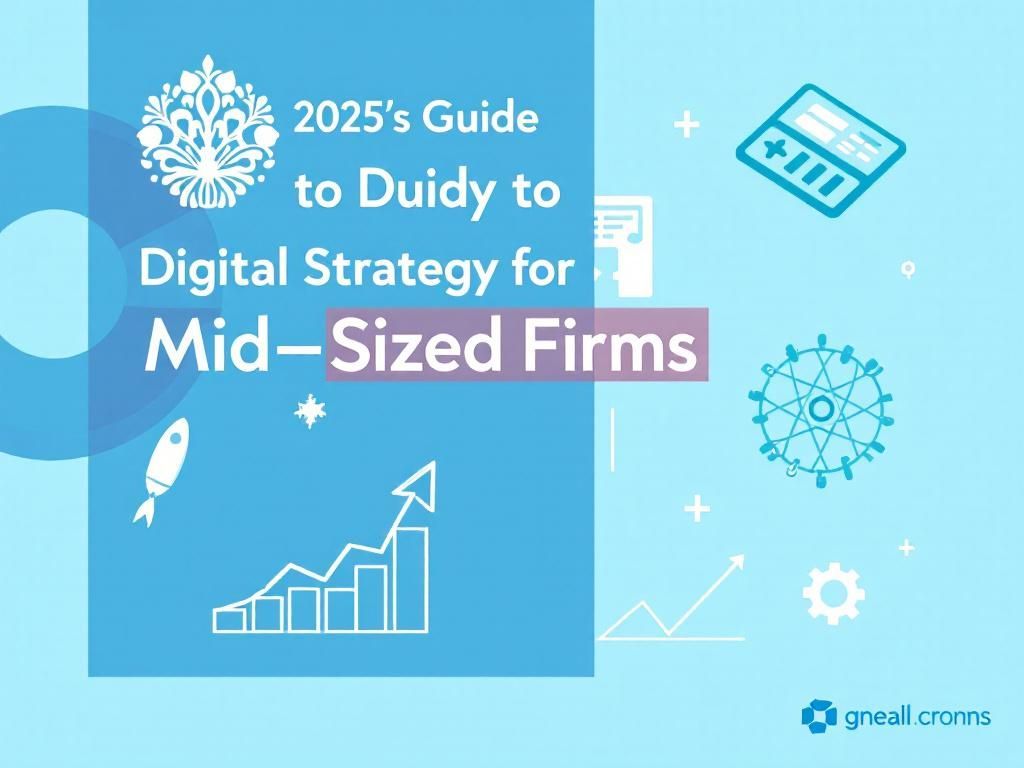2025 Digital Strategy Guide for Mid-Sized Firms
Explore essential digital strategies for mid-sized firms in 2025 to enhance growth and competitiveness in the evolving market.

In the fast-evolving landscape of digital technology, mid-sized firms are poised to leverage innovative strategies to enhance their market positioning and operational efficiency. As we approach 2025, it is imperative for these businesses to adapt and integrate digital solutions that not only optimize processes but also align with their long-term goals. This guide provides a comprehensive overview of digital strategy tailored for mid-sized firms, highlighting key trends, tools, and best practices.
Table of Contents
Understanding Digital Strategy
Digital strategy refers to the integration of digital technologies into all areas of a business, fundamentally changing how organizations operate and deliver value to customers. For mid-sized firms, a robust digital strategy is essential for:
- Enhancing customer engagement
- Streamlining operations
- Improving decision-making processes
- Driving innovation
The Importance of a Digital Mindset
A digital mindset is crucial for the successful implementation of digital strategies. This involves fostering a culture that embraces change, encourages experimentation, and values data-driven decision-making. Key aspects include:
- Leadership Commitment: Senior management must champion digital initiatives to drive organization-wide adoption.
- Continuous Learning: Encourage employees to develop digital skills through training programs and workshops.
- Collaboration: Promote cross-departmental collaboration to harness diverse perspectives and expertise.
Key Digital Trends for 2025
To remain competitive, mid-sized firms must stay abreast of emerging digital trends. Here are some key areas to focus on:
Artificial Intelligence and Automation
AI and automation technologies are transforming business operations, enabling firms to automate routine tasks, enhance customer service, and make data-driven decisions. Examples include:
| AI Application | Description |
|---|---|
| Chatbots | Provide 24/7 customer support and engage with visitors on websites. |
| Predictive Analytics | Help forecast market trends and customer behavior based on historical data. |
| Robotic Process Automation (RPA) | Automate repetitive tasks, freeing up employees for higher-value work. |
Data-Driven Decision Making
Data is the backbone of effective digital strategy. Mid-sized firms should invest in:
- Data Analytics Tools: Utilize tools like Tableau or Google Analytics for actionable insights.
- Customer Relationship Management (CRM) Systems: Implement systems like Salesforce to manage customer interactions and data.
- Business Intelligence (BI) Platforms: Use BI platforms to analyze data and support strategic decisions.
Implementing Your Digital Strategy
Once you have identified key trends, the next step is to implement a structured digital strategy.
1. Define Your Objectives
Start by outlining clear, measurable objectives for your digital initiatives, such as:
- Increasing website traffic by 30% in one year.
- Improving customer satisfaction scores by 15%.
- Reducing operational costs by 20% through automation.
2. Assess Current Capabilities
Conduct a thorough assessment of your current digital capabilities, including:
- Existing technology infrastructure
- Employee skill levels
- Current processes and workflows
3. Develop an Action Plan
Create a detailed action plan that includes:
- Specific initiatives to implement
- Timelines for execution
- Resources required
4. Monitor and Adjust
Regularly track the performance of your digital initiatives against set objectives and be prepared to adjust your strategy as needed. This can involve:
- Reviewing analytics reports
- Gathering feedback from employees and customers
- Benchmarking against industry standards
Tools and Technologies for Effective Digital Strategies
To implement your digital strategy efficiently, consider leveraging the following tools and technologies:
Content Management Systems (CMS)
A robust CMS like WordPress or Joomla can enhance content delivery and improve user experience on your website.
Marketing Automation Platforms
Tools such as HubSpot or Marketo streamline marketing efforts by automating email campaigns and social media posts.
Project Management Software
Utilize platforms like Asana or Trello to manage projects, track progress, and enhance team collaboration.
Measuring Success
To gauge the effectiveness of your digital strategy, establish key performance indicators (KPIs) such as:
- Website traffic growth
- Conversion rates
- Customer retention rates
Regularly review these metrics to identify areas for improvement and ensure your digital initiatives are aligned with business objectives.
Conclusion
As mid-sized firms navigate the complexities of the digital landscape, a well-defined digital strategy will be crucial for sustained growth and success by 2025. By embracing technology, fostering a digital mindset, and continuously evaluating performance, these organizations can position themselves as leaders in their respective industries. Start your journey today to unlock the full potential of digital transformation.
FAQ
What is a digital strategy for mid-sized firms?
A digital strategy for mid-sized firms involves creating a roadmap that integrates digital technologies with business goals to improve operations, enhance customer engagement, and drive growth.
Why is digital transformation important for mid-sized businesses in 2025?
Digital transformation is crucial for mid-sized businesses in 2025 as it enables them to remain competitive, improve efficiency, and adapt to changing consumer behaviors in a rapidly evolving digital landscape.
What key components should be included in a digital strategy for mid-sized firms?
Key components of a digital strategy for mid-sized firms should include customer experience enhancement, data analytics, digital marketing, cloud computing solutions, and cybersecurity measures.
How can mid-sized firms leverage social media in their digital strategy?
Mid-sized firms can leverage social media in their digital strategy by engaging with customers, promoting their brand, and utilizing targeted advertising to reach specific demographics.
What role does data analytics play in a mid-sized firm’s digital strategy?
Data analytics plays a vital role in a mid-sized firm’s digital strategy by providing insights into consumer behavior, optimizing operations, and informing decision-making processes.
How can mid-sized firms measure the success of their digital strategy?
Mid-sized firms can measure the success of their digital strategy through key performance indicators (KPIs) such as website traffic, conversion rates, customer feedback, and return on investment (ROI) from digital initiatives.








